After finding a mysterious game from the Eighties named Curs>R, Kayla (Iola Evans) decides to play to try and win the prize money (via phoning into the voice of Robert Englund!) in new Netflix horror Choose Or Die.
She’s desperate for the money to get her and her mother (Angela Griffin) out of poverty and addiction, but she soon realises the game changes her reality, forcing her to make terrible choices with dire consequences. And she’s not its first victim. There’s also nostalgia-loving Hal (Eddie Marsan), and he’s just made a copy of the game…
With the help of computer programming buddy Isaac (Asa Butterfield), Kayla must face each terrifying level until she gets to the big boss and defeat the game once and for all.
We go behind the scenes Choose Or Die with director Toby Meakins and writer Simon Allen to make a few choices of our own…
When did you first come up with the idea for Choose Or Die?
Simon Allen: Toby and I have worked together for a very long time on short films. We’ve got this very collaborative relationship where one of us has half an idea or a weird thing and then the other one bolts something onto it.
We did a short film with Georgina Campbell which is really cool called Floor Nine And A Half and it was a weird idea. It was about being followed from the front. And if the person who’s being followed from the front turns, the person that’s following them is always there and you can always see the back of their head. Toby added loads to that and made it into something really, really cool.
When we did that, and it was such a big success, everyone was like ‘what’s the next thing? Do you want to do features? Do you want to do a TV series?’ We came up with the idea of the tape loading game and the word ‘Curs>R,’ the connotations of it. I was like let’s make it an eight-bit entity. Let’s make this rudimentary thing a supernatural phenomenon and see what we can do with that.
Toby was the one who brilliantly added the detail of somebody contemporary who kind of dismisses this, or doesn’t know about this distant nostalgic culture. You need somebody contemporary being menaced by that and that’s how we started to develop it.
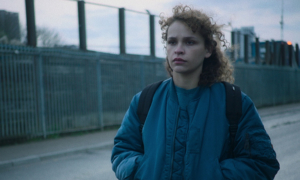
Why did you decide to use a videogame from the Eighties?
Toby Meakins: We basically realised that nostalgia for the Eighties was for us, it’s when we were little kids but for the generation now, it’s like antiquity. It’s quite scary for us to realise, ‘oh my god, the era when we were kids is seen as ancient history now’, but at the same time if you embrace that you can have a lot of fun with it.
Simon Allen: I started working in TV when I was 35 – quite late, because of my background, that’s how long it takes and all that – but they were all in their 20s and I would use these references and they didn’t know what the hell I was talking about!
There’s a presumption from a certain generation of what values are, what matters, what should be centred, which is embodied by Eddie [Marsan]’s character. There is a very clear disconnect between younger people and older people and the film isn’t entirely about that, but it does speak to that conflict through the dynamic between Kayla and what Eddie represents and what the game represents where it came from.
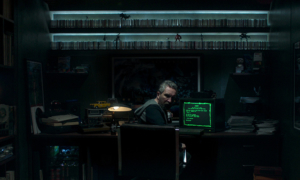
Toby Meakins: You’ve got Eddie on the toxic side of that and you’ve got Asa in the middle between the two worlds. Asa’s character represents the non-toxic side of nostalgia, whereas Edie really represents a toxic side of nostalgia.
Simon Allen: [Isaac] likes Duran Duran, I couldn’t get Duran Duran in the film because Toby hates Duran Duran, but Asa’s character likes Duran Duran I think…
Toby Meakins: Asa [Butterfield]’s character is a bridge between that. Asa’s character is some kind of modern-retro-historian for want of a better word. So he’s the link. Kayla is very much like, Robert Englund? Literally WHO THE FUCK IS THAT? Why do I care about him? [laughs]
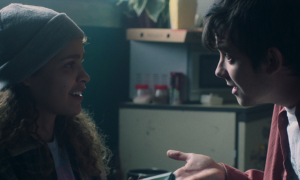
Simon Allen: It does feel like generations just can’t talk to each other about certain things. Particularly on climate change, (I’m working on a climate change project at the moment). It’s bewildering how much denial and disinterest there is from the generation that arguably is unconsciously or consciously complicit in making it worse. I think there is something about that entitlement in my generation, our generation and older than us – an unwillingness to cede power and to acknowledge that change is necessary.
It’s rare to have a female protagonist in a gamer story. What made you decide to have Kayla as the central character in Choose Or Die?
Simon Allen: There are so many embedded structures, presumptions, and power influences systemically, that I think that it was really important that she was a female character. I think there’s something about when she turns around to Eddie and says, “fuck the Eighties”. I would have called the film ‘fuck the Eighties’ if I could have gotten away with it [haha].
I think there’s so much power and primacy in that statement, because it’s almost a form of heresy when you look at gamer gate and toxic fanboys. It’s so bad, the misogyny in that situation. So we really wanted to make sure that we had a character that stood up against that and disrupted that and represented what progress might have to look like. How brutal progress might actually have to be. It was really important that we dramatised or represented her oppression and her lack of opportunity.
But it was also really important that you saw some joy in her life too and Toby put this beautiful scene with her and Asa when they first meet.
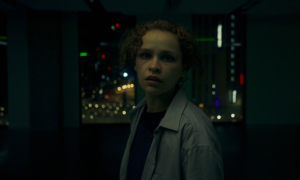
Why did you decide to go down the horror route for Choose Of Die?
Toby Meakins: It comes from the short. This is what we’ve done together. I think Simon would have loved to put it into more of an Amblin space and actually we kind of lent there a little bit, but it is simply because it’s what we love to do.
Simon Allen: Also because politically, we are trying to say we think it is horrific. We think the lack of opportunity, and the lack of progress, and the lack of fairness is horrific. There was a very influential piece written by a brilliant journalist about Floor Nine And A Half, where she saw things about Generation Z, work-life balance and zero-hours contracts in a two-minute short, that I wish we’d intended, but we didn’t [haha].
That did influence us a bit in terms of selecting the horror experience, because we thought, okay, if people were seeing that in two minutes, maybe they’ll see these resonances in 80 or 90 minutes…
Toby Meakins: Floor Nine And A Half was this kind of Kafkaesque horror and from the outset we were trying to make a film that we really hoped a purist horror audience could enjoy but also, bridge the gap. My brother who’s a builder could watch and enjoy it. That was really important for us and I hope we’ve got the balance, right. I really do. That was always our intention with this and it was always our intention with the shorts. We want people to see our work and it’s really important it finds as big of an audience as possible.
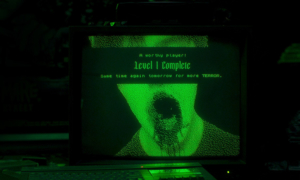
Speaking of that balance, this isn’t an all-out gore-fest horror. How did you go about maintaining a fair mix between horror and heart in Choose Or Die?
Toby Meakins: It was the hardest part of the whole project but I think that’s because we got it right. It was the one thing that every day I’d have breakfast with the first AD, and every day I’d walk in and I’d go; ‘What have we got today? What’s the balance? How’s it going to work?’ I’m darker than Simon is generally in terms of my tastes, maybe not my tastes, but in terms of my outlook in life…
Simon Allen: I’m sentimental I’m sorry. I like love stories!
Toby Meakins: The two of us work really well in that way because I’m like, ‘don’t be too soft’ and he’s like ‘don’t be too hard’. Before we did the voice recording with Robert England, he’d read the script and said, ‘I get sent a lot of stuff and I don’t do a lot of it. This is great, but make sure that there’s some joy and fun in it because you can do that in horror. It’s there to serve that purpose’. My instincts were to make Asa’s character darker but I didn’t do that.
We talked a lot about this, that he was bringing a lot of levity to the part, and a lot of the time I was like, ‘maybe we should tone it back?’ Is it going to balance with her coming out of something so hard and then Asa’s got this little light of hope in him?’
Actually, I think we got it right but as a first-time film director it was the scariest part. Not doing the set pieces, not the setups, none of that, it was that balance that was the scariest!
Simon Allen: One of the things Toby is very good at is [not delivering] the normal patterns that you fall on in storytelling. This does that to a certain degree and there’s a very rudimentary structure but then it steps off, or it doesn’t quite do what you think it’s going to do. I think that was probably quite important.
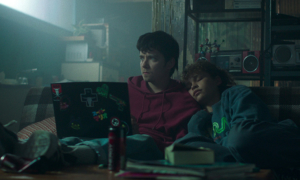
Where did you shoot Choose Or Die?
Toby Meakins: We shot in London. There’s no studio space in the UK anymore, especially for an Indie film. It was basically shot as an Indie film in the UK, and then we sold it to Netflix. So it wasn’t shot with Netflix money, it was shot with UK indie film money! So it’s a remarkable achievement in that respect.
We had a great crew and we had a warehouse in Wembley, where we built the sets. We had a week and a half there and we shot a lot of the interiors there. There was also an office building there that we shot the Kismet offices scenes in.
Then we went to Holloway prison in North London and that’s the exterior of the projects. They had an old swimming pool there and we did the corridor stuff there.
The scene where there’s the blue door, red door was shot at the end of the film. We went back to Wembley while they rebuilt some sets, and them going through the corridors was in one part of Holloway prison, and then the swimming pools was in another part and then there was another corridor from somewhere else. So that scene, just them getting into the corridor and through to the swimming pool, was shot in four separate sections over the course of three weeks! It’s kind of mad and you have to work like that!
Again, this is where the relationship with Simon and I comes back into it because we’ve made shorts together. It’s like, ‘okay, we’ve got this location, we’ve got funds, we know what we want to do, and how we want to do it but how can we adapt it around the location where it still makes sense?’.
It was proper like independent filmmaking. It was hard, but it was good. It was very satisfying.

What do you want for audiences to take away from Choose Or Die?
Toby Meakins: I want a couple of things, personally for my own satisfaction, I guess more than anything I’d like people to watch it and go ‘yeah, there’s some really cool, original ideas in there that have been done really well’. But I also want people to go ‘yeah, that was that was a ride, that didn’t bore me, that didn’t waste 85 minutes of my life!’ Haha!
Simon Allen: I want them to be thinking ‘fuck yeah, fuck the Eighties, fuck everything. Let’s go. Let’s do it!’ I think that’s the point.
There is a big, bold, triumphant moment at the end of the movie but what Toby has put into it is that note of uncertainty, the ambiguity of yes, just because you have power, it doesn’t necessarily mean you’ll wield it wisely. But I think ‘fuck the Eighties’ would be my takeaway!
Choose Or Die is out now on Netflix. Read our review here.
